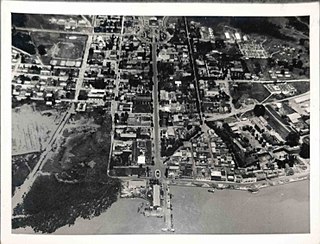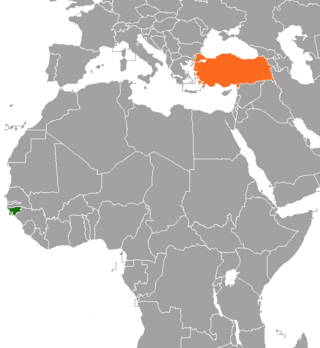
The recorded history of Cape Verde begins with the Portuguese discovery of the island in 1458. Possible early references to Cape Verde date back at least 2,000 years.

Bissau is the capital and largest city of Guinea-Bissau. As of 2015, it had a population of 492,004. Bissau is located on the Geba River estuary, off the Atlantic Ocean, and is Guinea-Bissau's largest city, major port, its administrative and military center.
"Esta É a Nossa Pátria Bem Amada" is the national anthem of Guinea-Bissau. Written in 1963 by Amílcar Cabral (1924–1973) and composed by Xiao He (1918–2010), it was adopted upon independence from Portugal in 1974.

The Community of Portuguese Language Countries, also known as the Lusophone Community, is an international organization and political association of Lusophone nations across five continents, where Portuguese is an official language. The CPLP operates as a privileged, multilateral forum for the mutual cooperation of the governments, economies, non-governmental organizations, and peoples of the Lusofonia. The CPLP consists of 9 member states and 33 associate observers, located in Europe, South America, Asia, Africa and Oceania, totaling 38 countries and 4 organizations.

Luís Severino de Almeida Cabral was a Bissau-Guinean politician who was the first President of Guinea-Bissau. He served from 1974 to 1980, when a military coup d'état led by João Bernardo Vieira deposed him. Luís Cabral was a half-brother of Amílcar Cabral, with whom he co-founded the African Party for the Independence of Guinea and Cape Verde (PAIGC) in 1956.

Portuguese Guinea, called the Overseas Province of Guinea from 1951 until 1972 and then State of Guinea from 1972 until 1974, was a West African colony of Portugal from 1588 until 10 September 1974, when it gained independence as Guinea-Bissau.
Articles related to Guinea-Bissau include:

Air Bissau was the national airline of Guinea-Bissau, operating services from its base at Osvaldo Vieira International Airport in Bissau.
Nuno Tristão was a 15th-century Portuguese explorer and slave trader, active in the early 1440s, traditionally thought to be the first European to reach the region of Guinea. Legend has it that he sailed as far as Guinea-Bissau, however, more recent historians believe he did not go beyond the Gambia River).

The Ceres series of Portuguese postage stamps is a definitive series depicting the Roman goddess Ceres that was issued between 1912 and 1945 in Portugal and its colonies.

The Pidjiguiti massacre was an incident that took place on 3 August 1959 at the Port of Bissau's Pijiguiti docks in Bissau, Portuguese Guinea. Dock workers went on strike, seeking higher pay, but a manager called the PIDE, the Portuguese state police, who fired into the crowd, killing at least 25 people. The government blamed the revolutionary group African Party for the Independence of Guinea and Cape Verde (PAIGC), arresting several of its members. The incident caused PAIGC to abandon their campaign of nonviolent resistance, leading to the Guinea-Bissau War of Independence in 1963.
Portuguese Sign language is a sign language used mainly by deaf people in Portugal.
Cape Verdean Bissau-Guineans are Bissau-Guineans residents whose ancestry originated in Cape Verde.
The Two Faces of War is a 2007 Portuguese documentary film directed by Diana Andringa and Flora Gomes. The film was shot in Guinea-Bissau, Cape Verde and Portugal. The film includes a series of interviews and testimonies of people who lived through the period of the anti-colonial war and liberation in Guinea-Bissau.
Raúl Pires Ferreira Chaves was a Portuguese civil engineer and inventor. A graduate of the Instituto Superior Técnico of Lisbon, he lived and primarily worked in Portugal, Portuguese Cape Verde and Portuguese Guinea.

The official language of Guinea-Bissau is Portuguese, which was spoken by 32.1% of the population according to the 2009 census. It is the language of instruction in schools, the language of literary production, the written press, legislation and administration.
The Liberation Front of Portuguese Guinea and Cape Verde was a militant political party in Guinea-Bissau, then part of Portuguese Guinea, formed to seek independence from Portugal.
Manuel Ferreira was a Portuguese writer that became known for his work centered around African culture and literature.

Guinea-Bissau–Turkey relations are the foreign relations between Guinea-Bissau and Turkey. Turkey has an embassy in Bissau. Guinea Bissau has an embassy in Ankara.

Karyna Gomes is a Bissau-Guinean singer and journalist of Cape-Verdean descent. She was the co-founder of the peace movement Miguilan or Minjderis di Guiné No Lanta. In 2021, she led the coordination of the first journalism projects in various types of Creole languages, which was developed with the help of the Portuguese online journal Mensagem de Lisboa. As a journalist, she has worked with organizations such as the Associated Press and RTP. She has released two musical albums since the start of her music career in the late 1990s.












